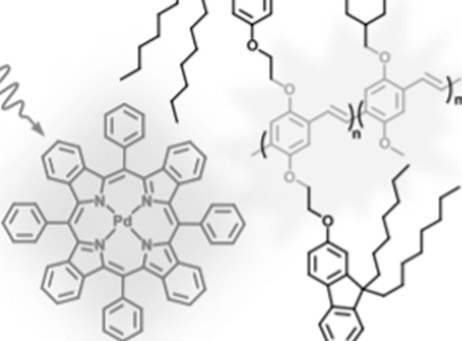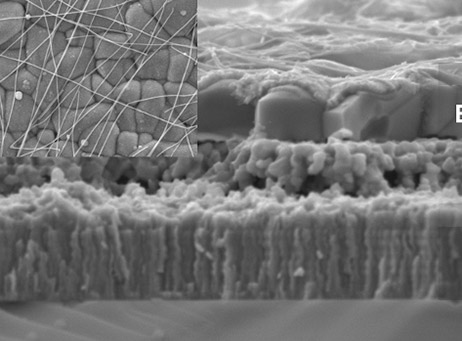Theme 1
Excitonic Systems for Solar Energy Conversion
We are building the ultimate light-harvesting system by efficient conversion and transport of excitons.
This involves spectral and spatial manipulation of the solar spectrum, with downshifting and upconversion to compress broadband sunlight into a narrow band for efficient harvesting by next-generation, solution-processed excitonic solar cells. This theme delivers new, light-harvesting concepts and novel, full-spectrum materials for next-generation, low-cost, high-efficiency excitonic light-harvesting devices.
Theme 1 comprises two research platforms; Excitonic Light Management (Platform 1.1) and Solution-Processed Next Generation Photovoltaics (Platform 1.2). Currently the fundamental maximum theoretical efficiency for conversion of light into current for a single solar cell, called the Shockley-Queisser (SQ) limit, is approximately 30% for Si based technology. Combined, these Theme 1 Platforms seek to design hybrid solar cell systems which can surpass the SQ limit.
Platform 1.1 - Excitonic Light Management
Platform Leader: Timothy Schmidt
Deputy Platform Leader: Wallace Wong
Platform Co-Ordinator: Jessica Alves
The goal of this platform is to tame the solar spectrum, by controlling the energy and spatial dimension of light. By doing this we aim to exceed the 34% Shockley-Queisser efficiency limit for light-to-electricity energy conversion.
Photochemical upconversion is the process of converting two low-energy photons into one of higher energy. Designing materials which can exploit this process would allow us to utilise energy from the infrared part of the sun’s spectrum and transform it into higher energy so it can be converted into electric current.
Luminescent solar concentration is a process whereby the energy density of light hitting a surface can be increased by concentrating the light absorbed over a large area into a much smaller area via waveguiding. A Luminescent Solar Concentrator (LSC) can improve the efficiency of upconversion and also allow solar energy collection to be integrated into building architecture.
Despite continued challenges posed by the COVID-19 pandemic, theoretical research to guide future efforts has obtained promising results, with projects either published or in advanced stages.
An upconversion system with record efficiencies for red to yellow solution has been demonstrated.
Work continues on quantum dot LSCs, NIR hybrid upconversion, mixed organic/inorganic systems, device fabrication methods and research into magnetic field effects on upconversion.
Platform members are working with University of Technology Sydney and craft brewery Young Henrys on an agrivoltaics project aimed at producing carbon neutral beer through stimulated algae growth. Cheers to that!
People
Chief Investigators
| Name | Node |
|---|---|
| Alison Funston | Monash University |
| Asaph Widmer-Cooper | University of Sydney |
| Dane McCamey | UNSW Sydney |
| Jared Cole | University of Melbourne |
| Ken Ghiggino | University of Melbourne |
| Paul Mulvaney | University of Melbourne |
| Salvy Russo | RMIT |
| Timothy Schmidt | UNSW Sydney |
| Wallace Wong | University of Melbourne |
| Trevor Smith | University of Melbourne |
Associate Investigators
| Name | Node |
|---|---|
| Angèle Reinders | Eindhoven University of Technology |
| Gary Rosengarten | RMIT |
| Nicholas (Ned) Ekins-Daukes | UNSW Sydney |
Postdoctoral Research Fellows
| Name | Node |
|---|---|
| Siobhan Bradley | University of Melbourne |
| Laszlo Frazer | Monash University |
| Thilini Ishwara | UNSW Sydney |
| Stefano Bernardi | University of Sydney |
| Igor Lyskov | RMIT |
| Nicholas Kirkwood | University of Melbourne |
| Nicolau Saker Neto | University of Melbourne |
| Jessica Alves | UNSW Sydney |
| Philip Jiale Feng | UNSW Sydney |
| Pria Ramkissoon | University of Melbourne |
| Shyamal Prasad | UNSW Sydney |
| Elham Gholizadeh* | University of Melbourne |
Postgraduate students
| Name | Node |
|---|---|
| Benjamin Tran | UNSW Sydney |
| Jack Heywood-Day | University of Melbourne |
| Paulo Simon | University of Melbourne |
| Jiho Han | University of Melbourne |
| Riley O'Shea | University of Melbourne |
| Arun Ashokan | University of Melbourne |
| Cameron Dover | UNSW Sydney |
| Elham Gholizadeh* | UNSW Sydney |
| Junhan Kong | Monash University |
| Na Wu | University of Melbourne |
| Tim Warner | RMIT |
| Rosie Pelosi | UNSW Sydney |
| Rehana Pervin | University of Melbourne |
| Michael Rinaudo | University of Sydney |
| Roslyn Forecast | RMIT |
| Engin Akinoglu | University of Melbourne |
| Damon de Clerq | UNSW Sydney |
*Completed PhD and moved to Exciton Science Postdoc position
Progress towards Project Scope
Solid State Upconversion
In seeking progress towards a solid-state upconversion device, more molecules were discovered to display upconversion characteristics. The violanthrone studies in solid state demonstrated that a crystal engineering approach is needed. Also, theoretical research is becoming a valuable tool to assist device design.
Quantum Dot Luminescent Solar Concentrators
Insight on the spatial orientation of quantum dots and the design of hybrid quantum dots systems was a topic of interest. Such investigations are the basis to succeed in developing high efficiency green light-harvesting luminescent solar concentrators.
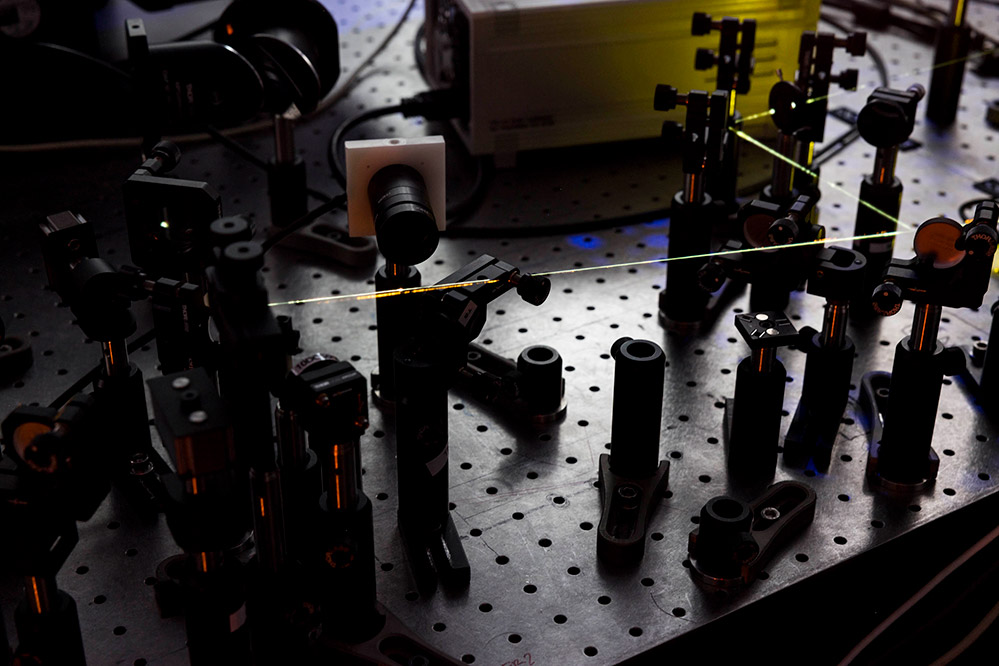
Progress update in 2021
Research has been severely impacted by COVID-19 restrictions, limiting the ability to perform lab work and the availability of skilled personnel.
Preliminary results on some topics within the platform have also encountered some setbacks. The study of polymers for upconversion has been proven to be more challenging than expected with low upconversion efficiency reported for all systems investigated thus far. There is a publication discussing the limitations by Chief Investigator Wallace Wong. The cause of the low efficiency is the bulkiness of the large polymer molecules which hinders key energy transfer and triplet-triplet annihilation processes. Furthermore, upconverting systems less sensitive towards oxygen (yet to be found) are essential to continue the work on scanning near-field optical microscopy (SNOM).
Theoretical research has obtained positive and promising results, with projects either published or in advanced stages. It is expected that the outcomes of the theoretical research will help guide future research.
Upconversion below the silicon bandgap was published by CI Timothy Schmidt in 2020. The same system in solid state did not work. Schmidt also published a record efficiency red to yellow solution upconversion system in Energy and Environmental Science.
Regarding luminescent solar concentrators, CIs Schmidt and Dane McCamey are in monthly meetings with University of Technology Sydney about the algae project, aiming at the development of an LSC able to shift the sunlight range into the photosynthetic range. The entrepreneur funding for a project with Young Henrys, UTS and agrivoltaics has been received and advertising is set to commence soon. A new student was attracted to develop optimised agrivoltaics PV panels (with AI Nicholas Ekins-Daukes and Schmidt).
Risk and Mitigation
COVID-19 continues to impact research program across the Centre
It is hoped there will not be further significant restrictions on lab access that substantially impact research. The Centre’s chief investigators are expected to recruit new group members to help with the experiments in the coming year. Recurring meetings will be set to assist communication and collective progress within the relevant groups.
Industry Collaborations

We are working with microbrewery Young Henrys on a project to optimise luminescence for algae growth.
Hi-Vis
The Hi-Vis road sign company we were working with ultimately did require LSCs.
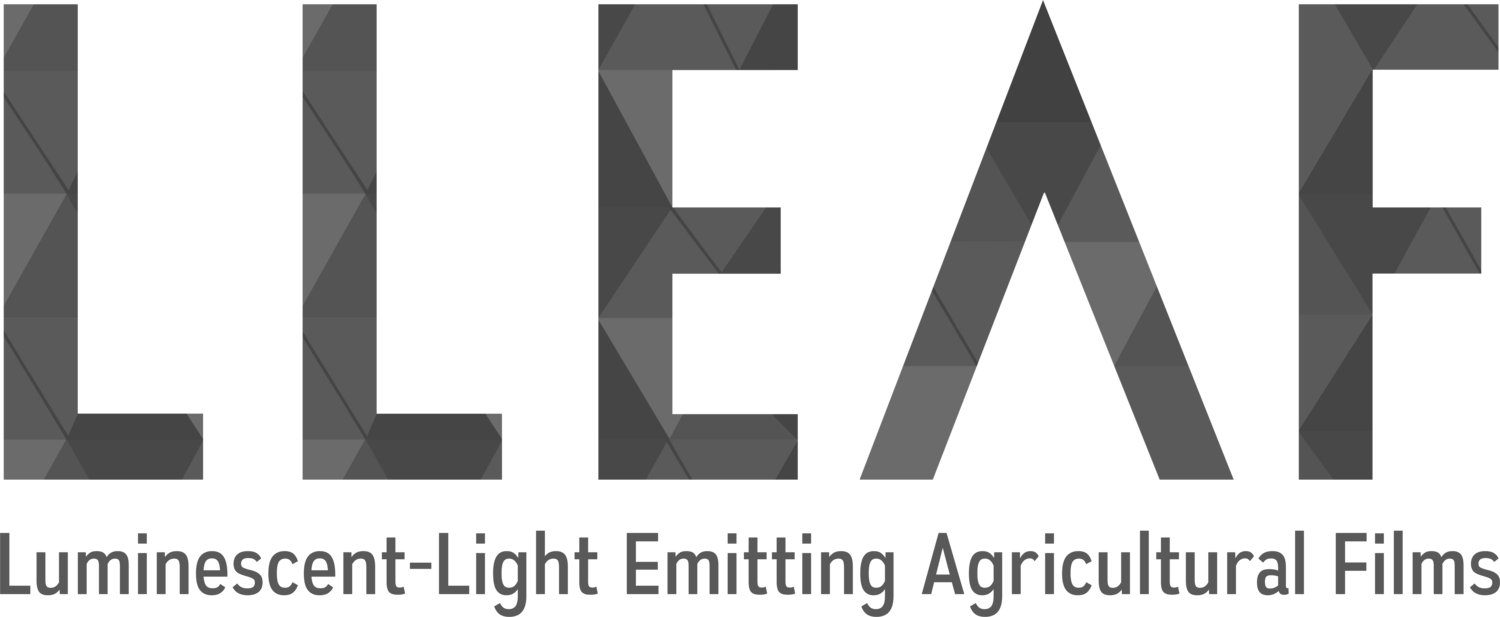
Discussions are taking place with the start-up Luminescent Light Emitting Agricultural Film (LLEAF) on LSC-type spectral manipulation for plant growth.

ClearVue is a commercial partner on aspects of CI Paul Mulvaney and AI Gary Rosengarten to research the investigation of luminescent semiconductor nanocrystals in polymer waveguides and their performance as luminescent solar concentrators.
International Participation
CIs Ghiggino, Trevor Smith and Paul Mulvaney are collaborating with Prof K. Kramer (University of Bern) on the NIR Hybrid Upconversion Using PbS/lanthanides project.
Wong and Schmidt are members of a large consortium to have submitted to the journal Joule on LSC measurements. Wong and Schmidt are also working with AI Angèle Reinders at Eindhoven University of Technology on LSCs with cubic geometry.
Outlook to 2022
Luminescent Solar Concentrators
The Wong group is investigating the photophysics of imide-substituted naphthalene diimides, which are UV-harvesting components in LSCs. The goal is to change photophysical properties in aromatic solvents by the imide substituent. This project has a draft manuscript written and is awaiting theoretical calculations from the groups of CI Salvy Russo and AI Lars Goerigk. Wong will investigate perylene diimide (PDI) polymer materials. PDIs with functional groups for incorporation into polymers have been prepared. In the future, successful polymerisation will result in localised energy donor-acceptor FRET systems.
Additionally, Wong investigated quantum dots blended with two PDI dyes in a PMMA film. High concentration of the PDI molecule enabled a two-step FRET process whereby UV light is absorbed by the quantum dots, energy transferred through molecule, and emission from the dye. The FRET efficiency was as high as 97% with photoluminescence quantum yield reaching 95%. The internal quantum efficiency of the LSC was close to 70% with UV light excitation. To complete this work, Wong will fabricate and test the LSC/PV devices.
CIs Mulvaney, Ghiggino, Funston, Widmer-Cooper and AI Rosengarten (RMIT) are working on incorporating anisotropic Semiconductor Nanocrystals into LSCs in order to address loss mechanisms (fig 1). Optical modelling already completed indicates that overall efficiency can be substantially enhanced with suitable control of nanorod alignment. Flow and electric fields will be investigated as alignment methods in 2022. After that, LSC device assembly and performance will be assessed. Methods for aligning nanorods close-packed semiconductor monolayers using ligand depletion methods will also be investigated.
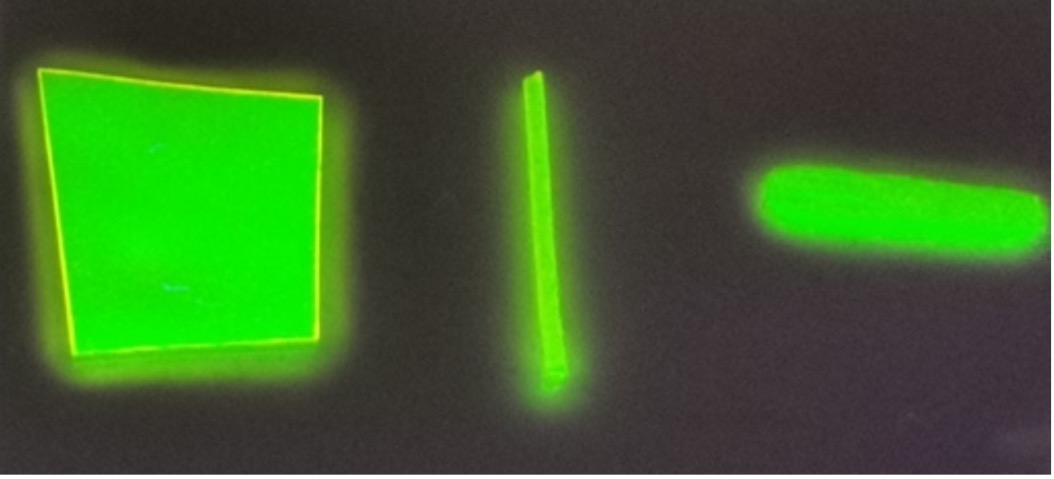
fig 1. Semiconductor nanocrystal luminescence in poly(vinylbutyral) waveguides.ults are shown for both slip (open symbols) and stick (closed and half-filled symbols) boundary conditions.
Upconverter systems
The Schmidt group will focus on designing upconverter systems from scratch, with significant input from computation calculations (mainly from the group of CI Jared Cole) guiding the process. An intelligent design will be sought to decrease competitive (and detrimental for upconversion) processes. Approaches can be to try to trap the Exciton (Baldo approach) or to turn down the triplet-triplet annihilation (TTA)/singlet fission (SF) interaction. SF happens in 100 ps, even in endothermic materials such as tetracene, and fluorescence cannot compete. However, triplets live for microseconds, and so the TTA probability does not need to be so large depending on the lifetime of the interacting pair, which is unknown. The idea, therefore, is to systematically tune crystal structures to control SF and TTA interactions.
Experiments on the magnetic field effect on upconverters are set to start in the beginning of 2022 involving the Wong and Schmidt groups.
Ghiggino, Smith and Widmer-Cooper have been working on understanding how to control the morphology of two-component organic nanoparticles, with particular interest in stabilising core/shell structures suitable for upconversion. A manuscript on this work is in preparation.
Ghiggino, Smith and Mulvaney are also involved in a project using PbS/lanthanides for NIR hybrid upconversion (fig 2). Measurements of efficiencies of light harvesting and upconversion process as well as device assembly and performance assessment are expected to be obtained within the next year.
New group members recently appointed across the platform or soon to start are meant to work on a range of topics in both upconversion and luminescent solar concentrations, such as, but not limited to: mixed organic/inorganic systems (bearing more stability), the effect of different microscopical shape of the upconverters (such as nanorods, nanoplatelets) in the presence of a magnetic field, understanding better the correlation between upconverters alignment and upconversion efficiency, and device fabrication methodology to affect the alignment/efficiency.
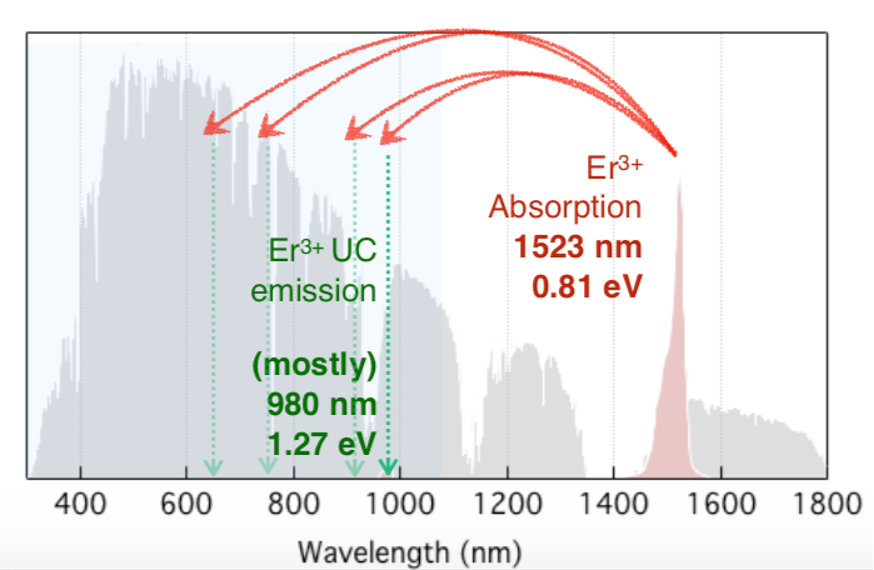
fig 2. Upconversion scheme for
lanthanide crystals.
Research Highlights in 2021
On the theoretical front, good progress is being made in the Cole and Russo groups (fig 3). Following on from the collaborative work with UNSW (Schmidt et al., fig 4), the Cole group is developing theoretical modelling to better understand magnetic field effects in up and down conversion. Cole and Russo published work towards the development of a more sophisticated model to understand the movement of triplet excitons in organic crystals.1 The goal of this work is to provide a toolkit for predicting a large array of suitable systems.
Schmidt has published upconversion using violanthrone-79 in both liquid and solid, which involved collaboration with the Cole or McCamey groups. Schmidt also published a high efficiency red to yellow upconversion.3 Additionally, Schmidt investigated the singlet-fission system in TIPS-pentacene solutions.4 Schmidt also published a perspective on upconversion.5
Wong has published poly(phenylene-ethynylene)s (PPEPPEs) as emitters in triplet-triplet annihilation upconversion (TTA-UC) (fig 5).6 This PPE system showed high photoluminescence quantum yield and a maximum upconversion quantum yield of 0.18% in solution. This system is better than state-of-the-art conjugated polymersother commercially available emitters in solution. Another publication revealed the influence of steric bulk on TTA-UC performance of poly(phenylene-vinylene)s() (fig 6).7 Wong has also published on the limitations of conjugated polymers as emitters in TTA-UC in Mater. Adv. (fig 7).8 Wong discovered that, despite the high photoluminescence quantum yield, the upconversion quantum yield was only 0.2% in solution due to the polymer steric bulk affecting triplet contact pair efficiency. Additionally, short triplet lifetimes contributed to high upconversion threshold.
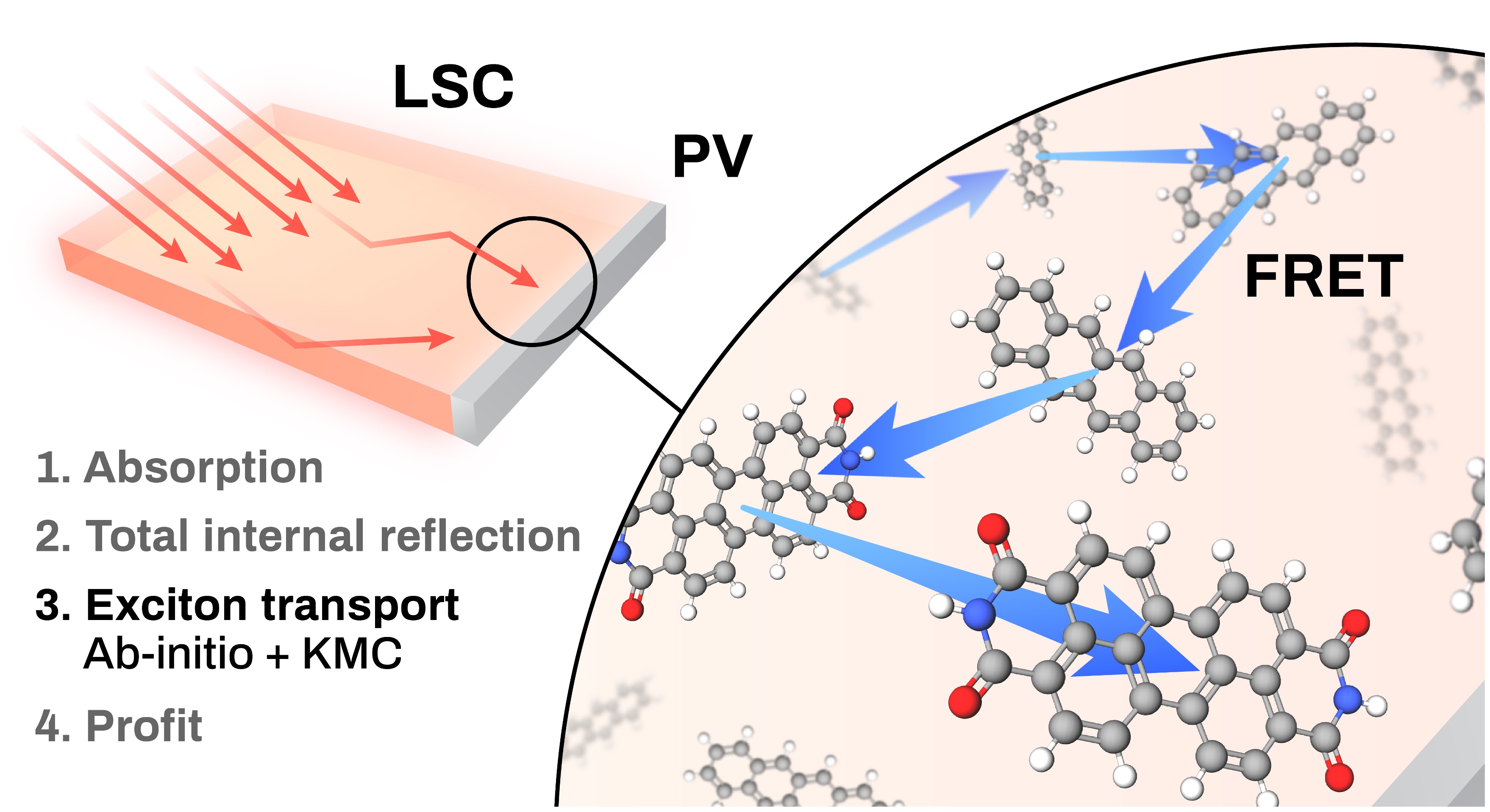
fig 3. Triplet excitons can be recycled into singlet excitons and ride the bus to get harvested.
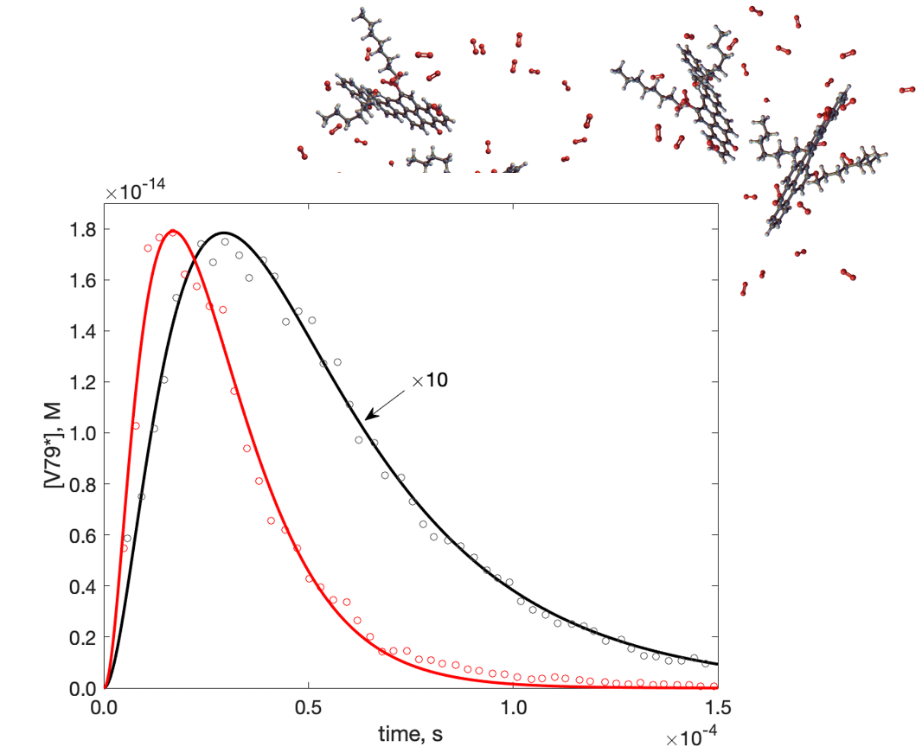
fig 4. Kinetic modelling of V79 upconversion by oxygen energy transfer based on the experimental results of Schmidt’s group.
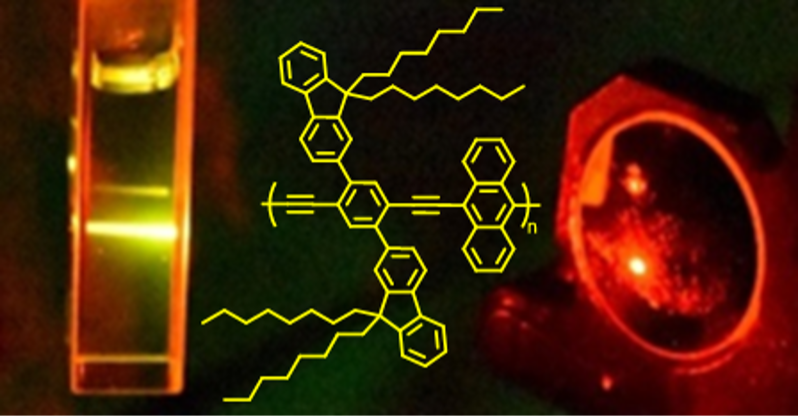
fig 5. Poly(phenylene-ethynylene)s as emitters in TTA-UC.
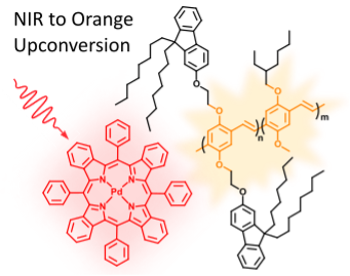
fig 6. Revealing the influence of steric bulk on TTA-UC performance of poly(phenylene-vinylene)s.

fig 7. Limitations of conjugated polymers as emitters in TTA-UC.
Relevant publications
1. J. Phys. Chem. C 2019, 123, 44, 26831–26841
2. J. Phys. Chem. C 2021, 2021, 125, 41, 22464-2247
3. Energy Environ. Sci., 2021, 14, 5541-5551
4. J. Am. Chem. Soc. 2021, 143, 34, 13749–13758
5. ACS Appl. Mater. Interfaces 2021, 13, 28, 32601–32605
6. Mater. Adv. 2021, 2, 2031-2035.
7. Sci. Rep. 2021, 11, 19585.
8. Mater. Adv. 2021, 2 (23), 7751-7758.
Platform 1.2 - Solution-Processed Next Generation Photovoltaics
Platform Leader: Jacek Jasieniak
Deputy Platform Leader: Udo Bach
Platform 1.2 aims to investigate emerging materials within solution-processed solar cell architectures that can go beyond silicon in efficiency or utility.
This is being achieved by developing new materials and device architectures through advanced theoretical and synthetic combinatorial screening approaches, advanced device simulation and characterisation methods.
Work Packages
Materials for Solar Cells: Work continues to identify the origin of and suppress ionic accumulation in perovskites devices.
Simulations continue to characterise the microscopic mechanism of growth of some perovskites in solution.
The Centre continues to develop microstructurally controlled solar cell absorbers on graphene electrodes and microstructurally controlled, lead-free and NIR thin films.
Device Fabrication and Characterisation: We are attempting to quantitatively describe the operation of a solar cells based on a new material or optoelectronic phenomenon and seeking to experimentally validate the predictions of a simulated solar cell device based on simulated material properties.
We have attempted to demonstrate fully optimized perovskite solar cells and a lead-free solar cell with a record efficiency. Understanding continues to be sought regarding the origins of instability of perovskite solar cells.
Novel Photovoltaic Concepts – Beyond Silicon: Targets include flexible PV using graphene electrodes, a back-contact perovskite solar cell with 15 % efficiency, a prototype NIR solar cell and semi-transparent solar cells with an efficiency of greater than 18% at an average visible transmittance of 10%.
A semi-transparent solar cell was certified to give an efficiency of 13.5% with an AVT of 22%. This is the highest known certified semi-transparent perovskite solar cell at this AVT.
People
Chief Investigators
| Name | Node |
|---|---|
| Ken Ghiggino | University of Melbourne |
| Salvy Russo | RMIT University |
| Timothy Schmidt | UNSW Sydney |
| Asaph Widmer-Cooper | University of Sydney |
| Paul Mulvaney | University of Melbourne |
| Jacek Jasieniak | Monash University |
| Udo Bach | Monash University |
Partner Investigators
| Name | Node |
|---|---|
| Anthony Chesman | CSIRO |
Associate Investigators
| Name | Node |
|---|---|
| Anita Ho-Baillie | University of Sydney |
Postdoctoral Research Fellows
| Name | Node |
|---|---|
| Adam Surmiak | Monash University |
| Boer Tan | Monash University |
| David McMeekin | Monash University |
| Gaveshana Sepalage | Monash University |
| Kevin Rietwyk | Monash University |
| Sebastian Olivier Furer | Monash University |
| Wenxin Mao | Monash University |
| Jae Choul Yu | Monash University |
| Narendra Pai | Monash University |
| Sri Matta | RMIT University |
| Tharindu Warnakula | Monash University |
| Manoj Sharma | Monash University |
| Tian Zhang | Monash University |
| Nastaran Meftahi | RMIT University |
| Babar Shabbir | Monash University |
| Wei Luo | University of Melbourne |
Postgraduate students
| Name | Node |
|---|---|
| Lara Gillan | UNSW Sydney |
| Madhuranga Rathnayake | University of Sydney |
| Monika Michalska | Monash University |
| Qingdong Lin | Monash University |
| Sarah Eskandarian | Monash University |
| Siqi Deng | Monash University |
| Samira Jama Aden | Monash University |
| Yanchen Zhou | University of Sydney |
| Yvonne Hora | Monash University |
| Qianying Guo | Monash University |
| Jie Zhao | Monash University |
| Yixiong Ji | University of Melbourne |
| Junlin Yan | Monash University |
| Boya Zhao | Monash University |
| Josh Moon | Monash University |
| Amit Kessel | Monash University |
| Wenqi Yan | Monash University |
| Daniel Balzer | University of Sydney |
| Julien Leoni | University of Sydney |
| Alison Campbell | University of Sydney |
Progress towards Project Scope
Materials for Solar Cells
Work by CIs Asaph Widmer-Cooper and Udo Bach to identify the origin of and suppress ionic accumulation in perovskites devices is still in progress. The lattice model has been extended to include vacancies and exciton diffusion.
Widmer-Cooper has further expanded these efforts through simulations of MAPbI3 in attempts to characterise the microscopic mechanism of growth of some perovskites in solution. This will continue following the start of a new postdoc in late 2021.
CI Paul Mulvaney, Jasieniak and PI Anthony Chesman are continuing work to develop microstructurally controlled solar cell absorbers on graphene electrodes. The deposition of graphene as an electrode has been started through a stamping process both for bottom and top electrode configurations. As part of these efforts, these have been used for reasonable efficiency (9.7%) CZTS solar cells. Exploration for use in perovskite devices is ongoing.
Work to develop microstructurally controlled, lead-free and NIR thin films with optimized composition and interfaces continues by Mulvaney, Jasieniak and Bach. The work on CZTS(Se) has continued with the demonstration of high quality thin-film formation fabricated using solution-based methods and subsequent use in solar cells that deliver up to 9.7% efficiency.
CI Salvy Russo remains focused on demonstrating DFT models suitable to describe the properties of bulk, grain boundary and interfaces in novel NIR perovskite solar cells. DFT calculations have been applied to key interface modifying layers of existing perovskites. Consideration of advanced interfaces for NIR materials will be undertaken once the materials screening approaches to identifying NIR materials has been completed.
Device Fabrication and Characterisation
Jasieniak, Bach and Russo are attempting to quantitatively describe the operation of a solar cell based on a new material or optoelectronic phenomenon using extracted device and material parameters. Simulation methods for solar cells with 1D, 2D and 3D configurations have been achieved. These are being used to better understand the operation of back-contact solar cells, solar windows and printed perovskite devices.
Jasieniak, Bach and Russo are also aiming to experimentally validate the predictions of a simulated solar cell device based on simulated material properties using a novel material class. Delays in achieving simulation approaches has impeded progress toward this milestone. Simple regressions have been made to validate the results, while more complex correlations to factors, such as morphological structure, ion diffusion and gradients are ongoing.
Bach, Jasieniak and Mulvaney are seeking to demonstrate a lead-free solar cell with a record efficiency. Work on AgBiI3, which has yielded efficiencies of 5.5%, continues to be a world record for silver bismuth iodide materials.
Bach and Jasieniak are working to demonstrate optimised perovskite solar cells with an efficiency of greater than 24%. While efficiencies of 22% were achieved in the lab in 2021, the significant impact of COVID and major staff changes has limited progress towards achieving this milestone. Instead, a greater focus on fundamental understanding into interfaces was prioritised.
Bach and Jasieniak also intend to understand the origins of instability of perovskite solar cells. Exploration of precursor purities showed that halide level impurities caused major issues in solar cell reliability and stability. Moreover, it was shown that instability using methylammonium with formamidium can arise from addition reactions that can create imide impurities.
Jasieniak sought to demonstrate a solar cell that can retain greater than 80% of efficiency under an equivalent 1 sun for more than 5,000 hours. However, due to COVID-19 and changes in staff, this goal was not achieved, instead devices with efficiencies of >1,000 hours have been achieved.
Novel Photovoltaic Concepts – Beyond Silicon
Jasieniak, Mulvaney and Chen’s focus on flexible PV (demonstrating a flexible solar cell using graphene electrodes that exhibits greater than 15% efficiency) is in progress. Major delays due to COVID-19 in accessing graphene were experienced.
Jasieniak and Mulvaney NIR-PV project, developing a prototype NIR solar cell with operating power of less than 1.2 eV and an efficiency of greater than 10% has resulted in CZTS devices with a bandgap in the NIR and an efficiency of 9.7% using silver nanowire/graphene electrodes.
Bach has been working on a back-contact perovskite solar cell, aiming for a 15% efficient device through selective interfacial modification of the absorbing layer and/or electrodes. Progress towards this activity has shown that devices with an efficiency of 11% can now be achieved.
Jasieniak and Chesman’s semi-transparent PV work attempted to harness full device optimisation capabilities across electrodes, interfaces and device architecture to fabricate semi-transparent solar cells with an efficiency of greater than 18% at an average visible transmittance of 10%. Composition and device engineering has shown that performance values of more than 15% can be achieved for devices with an AVT of greater than 20%.
Jasieniak and Chesman have also sought to demonstrate a fully integrated and operational semi-transparent solar cell in a double-glazed window configuration. Due to complications in accessing industry facilities due to COVID, this milestone has been delayed. Recent work has been focused on transferring graphene onto substrates for use within solar cell and other optoelectronic device applications.
Bach’s multi-junctions work aimed to demonstrate an all-solution-processed tandem solar cell with a conversion efficiency of 20%. However, progress on all multi-junction solar cells was stopped due to capacity limits in the Centre.
Bach, Jasieniak and Chesman sought to demonstrate a certified solar cell device structure that is either novel or the world’s highest so that it is suitable for inclusion within the NREL efficiency chart. A semi-transparent solar cell was certified to give an efficiency of 13.5% with an AVT of 22%. This is the highest known certified semi-transparent perovskite solar cell at this AVT.

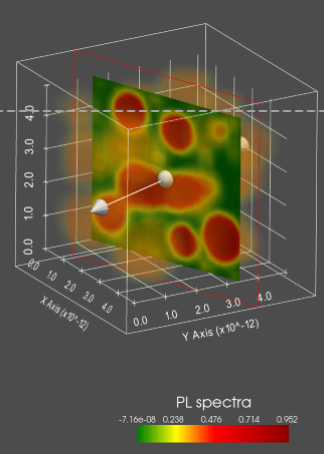
Simulated photoluminescence within a perovskite layer showing phase segregation.

Scanning electron micrograph of an ITO-free solution processed CZTSe-based solar cell device.

Schematic depiction of a semi-transparent perovskite solar cell (left) and the recorded solar cell efficiencies versus average visible transmittance (400 – 800 nm region) in comparison to existing works (right).
Progress update in 2021
Develop a high-throughput characterisation tool for photovoltaic devices capable of fabricating and testing devices 10x faster than with current conventional methods.
This has been completed with the commissioning of high-throughput measurement tools at Monash.
Understand the formation, deposition and structural evolution of low-temperature processed solar cell materials.
Significant work in this area has been made by Exciton Science, with at least five PhD students and multiple postdoctoral researchers working to achieve this goal. Progress over the past year has explored novel formulations for the deposition of Cesium and Formamidium-based metal halide perovskite compositions to afford long fluorescence lifetimes using alternative lead formulations and solvent mixtures to avoid anti-solvent or blow-drying approaches to fabricate devices.
Understand and overcome the current Eeg-Voc disparity and Jsc losses in spectrally tuneable perovskite and organic solar cells.
Work in this area is ongoing. Modelling efforts have provided greater clarity as to where current losses are in devices and device engineering has supported efforts to reduce the voltage disparity in order to achieve devices with an efficiency of greater than 21%. However, voltage losses continue to be high for larger bandgap perovskites, typically being 0.5-0.6 eV. This is suggestive that significant defects continue to plague these devices architectures, forming at or/and in the bulk of the perovskites. Overcoming these issues remains a key challenge towards achieving devices with efficiencies of 23% or above.
Develop advanced device modelling of solar cells to predict the operation of simulated materials and optimise functional devices.
Through the cross-node postdoc scheme, significant progress in this area has occurred. Detailed 1D, 2D and 3D simulation packages have now been developed and are being used to provide valuable guidance on how best to fabricate perovskites and other devices in thin-film and back-contact geometries. Machine learning approaches are starting to be integrated into these simulation methods to provide further guidance on how best to enhance solar cells with given performance characteristics.
Predict and experimentally validate a new photovoltaic material and its application in functional solar cells of reasonable performance.
We are harnessing machine learning approaches to discover new photovoltaic materials for simulations aimed at identifying which candidates would be most suitable for synthesis. We have used in-silico approaches to narrow down potential candidates from tens of thousands through to several dozen. These are now being considered in terms of the theoretical device performance and will be assessed experimentally as the next stage of this platform.
Demonstrate at least one new solar cell concept that provides a unique benefit over silicon solar cells.
Several key novel photovoltaic devices have been considered in this platform, including solar window, printed perovskites and back-contact solar cell devices. Record device efficiencies for each of these device architectures has been achieved.
Achieve a certified efficiency or operational lifetime world record for at least one emerging PV material.
COMPLETED. We have obtained certified results of a semi-transparent perovskite solar cell that delivers approximately 13.5% efficiency with an average visible transmittance of approximately 22%. Given the dearth of certification of semi-transparent solar cells, this represents a world record based on current values. Notably, our lab-based results have achieved approximately 15.5% at this AVT value.
Translate at least one new material or device architecture to large-scale printing trials.
COMPLETED. Novel formulations of SnO2 nanocrystal colloidal inks have been developed. These have been used on both small-scale devices to achieve 20% record perovskite devices and also harness in large-scale printing trials at CSIRO.
Risk and Mitigation
The prominent research program in perovskites and their application towards next-generation solar cells has relied on a steady stream of PhD students and high-calibre postdoctoral research fellows. With travel restrictions, significant reductions in PhD students is already being experienced across the relevant nodes. This will impact the skill translation between PhD cohorts. Moreover, our inability to recruit international postdocs has similarly created challenges in filling certain roles. This is becoming apparent now as many postdocs have recently finished or are about to finish. Filling these positions will depend on the travel restrictions easing.
Industry Collaborations
Industry connections in this platform have decreased during the COVID-19 era.
Engagement with RayGen has decreased due to capacity limits on Jasieniak, although there are ongoing works with AI Anita Ho-Baillie.
Our collaborations with Viridian Glass on solar windows have effectively ceased due to the company undergoing a corporate restructure with a more sales-focused approach.
Woodside Energy links continue through Monash University as part of its Woodside Monash Energy Partnership. While at this point Woodside is focused more on existing technologies, they have expressed ongoing interest in understanding emerging photovoltaic technologies that are closer to commercialisation.
International Participation
Existing and new collaborative works continue, although with significantly less momentum than pre-COVID.
Oxford – Udo Bach continues to collaborate with Henry Snaith.
Outlook to 2022
The outlook for 2022-24 will provide a focused activity on bridging simulation work and experimental devices, while also focusing on a select few solar cells that go beyond silicon. This will be done across several key areas that are directly related to the work packages of this platform. A high-level outlook for 2022 is included.
Accelerate solar cell materials discovery using high throughput synthesis, deposition and characterisation approaches.
- Establish the robotic facility for materials discovery at the MCN.
- Establish an environmentally controlled deposition and annealing glovebox system at Monash.
- Establish the combinatorial sputtering system at the MCN.
- Demonstrate at least one potential material class that has been developed through the accelerated materials discovery tools.
Develop advanced simulations that can help understand materials fabrication and solar cell simulation approaches that can predict the operation of solar cell devices with varying design, materials and operating conditions.
- Progress force field development to support nucleation of perovskites and two-step processing.
- Demonstrated optimisation of simulated photovoltaic device architecture based on materials derived from in-silico materials discovery approaches.
- Established material guidelines for back-contact, semi-transparent and near-infrared solar cells.
To advance several key solar cell technologies in both efficiency and stability that go beyond silicon, including solar windows, back-contact perovskites, printed perovskites, NIR solar cells
- To demonstrate a semi-opaque perovskite solar cell with a 10% efficiency at a 10% AVT.
- To improve back-contact solar cells to beyond 12% efficiency and solve key recombination challenges.
- To demonstrate a photovoltaic device harnessing a novel NIR material predicted from the big data machine learning filtering tools.
- Progress CZTS through interfacial and bulk engineering to achieve functional devices with an efficiency of greater than 11%.
Research Highlights in 2021
Melbourne’s buildings could be close to self-sustaining through fully integrated solar
Read more...